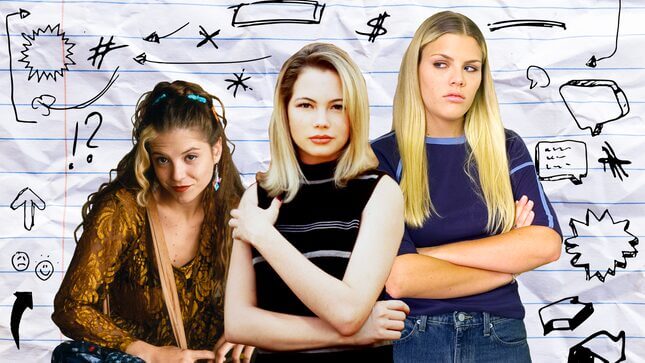A Love Letter to the Hopeless Bad Girls of '90s Teen Soaps, Who Never Got the Stories They Deserved
Rayanne Graff, Jen Lindley, Kim Kelly, and all the teen bad girls who deserved better
In DepthIn Depth
Illustration: Elena Scotti (Photos: Getty Images)
In the opening seconds of My So-Called Life’s single, nearly perfect, season, Angela Chase explains that she’s abandoned her existing group of twinset-wearing, yearbook-editing high school friends in order to playact panhandling with Rayanne Graff, a mismatched classmate as beautiful as she is troubled. Angela explains in an aside that if she didn’t get closer to Rayanne, she “might die or something.”
That’s the tragic beauty of the Rayanne Graff character: her breathless, frenetic energy seems like fun and games until the narrative reveals that all this breath play is actually dangerous, even potentially lethal. Rayanne walks a fine line between best friend and villain, but in the ethos of the dangerous ’90s girl, which includes Rayanne, Dawson’s Creek’s Jen Lindley, and Freaks and Geeks’ Kim Kelly, that line is never fully explored, cheating much more interesting narratives in favor of drawing a definitive line between girls who are hopeless and the heroines who are much easier to love. In the end, Angela gets Jordan Catalano and Joey gets both Dawson and Pacey, and Lindsey finally gets to pretend she’s Kim.
The crushworthy bad girls all of these series never get to be fully realized monuments to the beautiful confusion of teenage rebellion; instead, they languish as warnings against girlhood rebellion. The hopeless bad girls should have been treated with all the concern given to the virginal Angelas or the sexy leeway given to bad boys like Jordan. But the bad girls never really even got their own plotlines, much less the narrative space to spin a perpetually bad attitude into its own form of heroism. The underlying message, of course, is that there is only one type of girl who deserves a story: one who rebels without being too rebellious, one who can brush against trouble without getting stained by it. And as for all the troubled girls watching at home, hoping damaged didn’t mean broken beyond repair, well, too fucking bad.
-

-

-

-

-

-

-

-

-

-

-

-

-

-

-

-

-

-

-

-

-

-

-

-

-

-

-

-

-

-

-

-

-

-

-

-

-

-

-

-








































